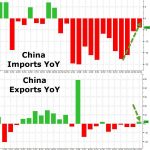Gold May Prosper in Good Times
First, gold may shine in unpleasant macroeconomic outlook. Generally, gold performs the best during economic slowdown or turmoil. In 2017, the economic conditions were far from recessionary climate. Global economic growth accelerated and became more synchronized among countries. The U.S. economy performed well, the unemployment rate achieved a record low, while inflation remained subdued. The Fed hiked interest rates three times, while the Republicans managed to pass a tax bill. And the U.S. stock market continued its rally, while the cryptocurrencies experienced a parabolic rise at the end of a year. Does it look like a supporting environment for gold? Not really. However, the price of the yellow metal has risen more than 12 percent in 2017, as one can see in the chart below. Perhaps it’s not very impressive, but not bad given the macroeconomic environment. And much better than a savings account or Treasuries.
Chart 1: Gold prices over the last twelve months.

Gold Is Mostly Tied to the U.S. Dollar
The reason why gold gained more than 12 percent in 2017, despite an unpleasant macroeconomic environment for the precious metals, was a weak greenback. The broad trade-weighted U.S. dollar index fell from 128 to 120, or more than 6 percent. Real interest rates are also an important driver of the price of gold, but the correlation was significantly stronger with the greenback in 2017. And the level of yield of the inflation-protected 10-year Treasuries at the end of the year was similar to the level at the beginning of the year (about 0.5 percent). The conclusion is clear: the decline in the U.S. dollar’s value clearly supported the yellow metal over the last twelve months. It is not surprising given the fact that gold is a bet against the greenback. Hence, the key to gold’s future is the U.S. dollar.
Gold Is Not a Perfect Hedge against Geopolitical Risks













Leave A Comment